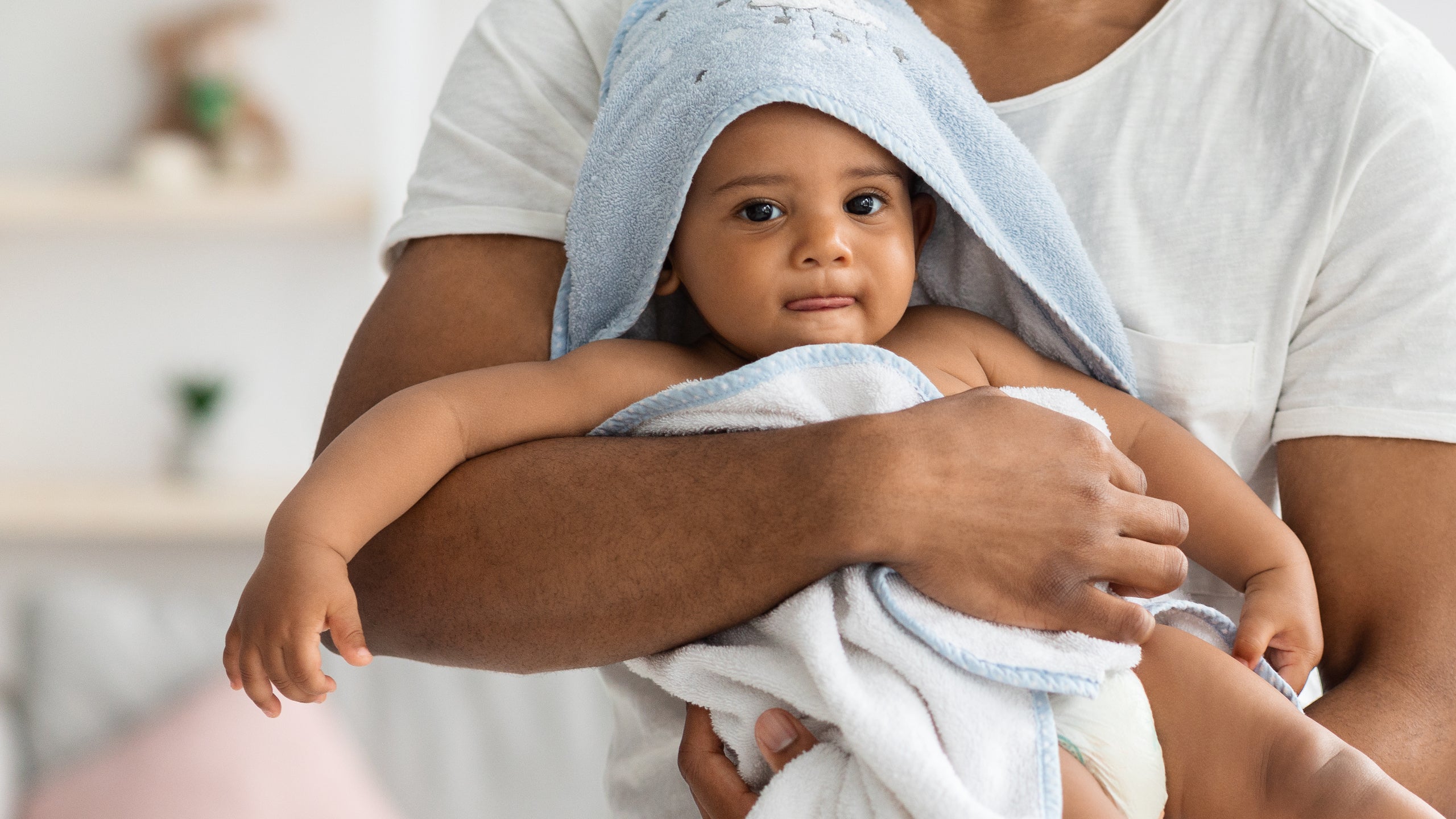Bubble baths seem like a lot of fun, but when your little one has eczema, this sudsy playtime can irritate their skin.
By skipping the bubbles and swapping your child’s bathtime routine for a gentler baby eczema bath, you can help reduce itching, minimize irritation, and lower your baby’s risk of experiencing another uncomfortable flare-up. Below, you’ll find everything you need to know about giving your little one an eczema-friendly bath.
Step-by-Step Instructions for a Baby Eczema Bath
Managing baby eczema during bathtime doesn’t need to feel confusing and overwhelming. By following these five simple steps, you can keep your little one clean without irritating their skin.
1. Fill the Bath with Lukewarm Water
When bathing your baby, make sure to use lukewarm water. Hot water can dry out the skin and worsen eczema symptoms. Rest assured, there’s no need to use cold water though.
2. Wash Your Baby with Hypoallergenic, Fragrance-Free Products
As fun as bath bubbles and other products can be, they often contain dyes, sulfates, and fragrances that can irritate sensitive eczema skin. For your baby’s next bath, skip the bubbles and opt instead for gentle, hypoallergenic products.
Another common culprit of eczema flare-ups is soap, which can contain harsh and drying ingredients that affect the skin’s delicate pH balance. Choose a gentle, fragrance-free cleanser instead. Remember that there’s no need to lather up your baby’s whole body: to protect their skin microbiome, only wash areas that are smelly or dirty. If you need to scrub a particular spot, use a soft cloth that’s been washed in fragrance-free detergent and gently rub your child’s skin.
For more information on which products to use during bathtime, read our complete guide to choosing baby skincare products.
3. Rinse and Soak for 5 to 10 Minutes
Just like hot-water baths, long baths can rob the skin of its moisture content and worsen eczema symptoms. To prevent drying out your baby’s skin, only allow them to soak for 5 to 10 minutes in the tub. You’ll have plenty of time to get your child clean, rinse them off, and give them a few minutes to splash and play.
4. Pat Your Baby Dry
After you take your baby out of the tub, resist the urge to rub them dry with a towel. This motion can be irritating to their skin. Instead of rubbing, simply pat your baby dry with a clean towel. To best protect your little one’s skin, only use a towel once before throwing it in the hamper with dirty clothes.
5. Moisturize Immediately After a Bath
Doctors commonly recommend the “soak and seal” method for babies with eczema. First, you “soak,” or bathe, your baby. Then, you follow up with the “seal.” Simply put, you “seal” in the moisture from the bath by applying cream within three minutes of patting your baby dry. Moisturizing with a baby eczema cream helps to rebuild your baby’s skin barrier and preserve its water content. 
Optional: Discuss Wet Wrap Therapy with Your Child’s Doctor
If your baby has moderate-to-severe eczema, they may benefit from wet wrap therapy, which involves wrapping a child’s skin in wet dressings after applying topical products and keeping the dressings on for several hours. If you’re struggling to manage your child’s eczema, ask their pediatrician or dermatologist if wet wrap therapy is appropriate for your little one. They’ll provide specific instructions on how to give your baby a wet wrap.
Is Bathing Good for Baby Eczema?
Bathing is an essential piece of any hygiene routine. However, bathing can have both positive and negative effects on the overall health of your baby’s skin. When done properly, though, the benefits far outweigh the side effects.
Bathing is crucial for your baby with eczema, because it helps keep the skin clean, which reduces your baby’s risk of infection. It can also cut back on irritation caused by dirt and sweat.
On the other hand, bathing your baby too frequently, or with harsh products or hot water, can dry out the skin and worsen eczema symptoms.
How Often Should You Bathe a Baby with Eczema?
There is no one-size-fits-all answer to how often you should bathe your baby with eczema. In general, if they’re dirty or sweaty, give them a bath. Many babies will only need a full bath a few times a week. For a more accurate answer on how frequently you should bathe your little one based on their skin condition, consult their dermatologist or pediatrician.
Should You Give Your Child a Bleach Bath for Baby Eczema?
Bleach baths are an eczema management tool that involves diluting a quarter to half cup of bleach into a full bath and soaking for ten minutes. Some research shows that bleach baths can improve eczema symptoms by reducing inflammation and itching. Other research says otherwise.
While bleach baths have potential benefits, they are generally recommended for children over age 2. Only give your baby a bleach bath if it has been recommended by their dermatologist or pediatrician and follow their instructions for duration and concentration of bleach closely.
Soak and Seal with Gladskin Eczemact™ Soothing Cream for Babies & Kids
Applying cream to your baby’s skin immediately after bath time is one of the easiest ways to help lock in moisture and soothe dry skin. When you soak and seal with Gladskin Eczemact™ Soothing Cream for Babies & Kids, you’re not only moisturizing your little one’s skin, you’re also rebalancing the bacteria that live on the skin’s surface.
Gladskin Eczemact™ Soothing Cream for Babies & Kids is minimally formulated, steroid-free, and dermatologist-approved for young children ages 3 months and up. It’s also oat-free, so it’s safe for children with oat allergies.
Learn more.
More Baby Eczema Resources
How to Avoid Dry Skin in Newborns
